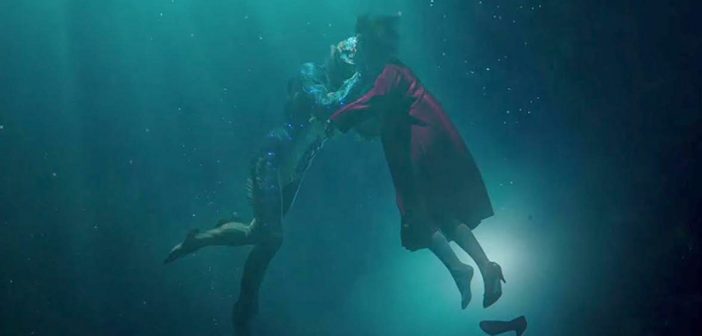This year, one of the 10 films vying for the Best Picture Oscar is The Shape of Water, a film by Mexican director Guillermo del Toro.
It’s safe to say this is the first year that a fishman/woman romance flick has been nominated for Tinselstown’s top award. We sat down with assistant professor of Spanish Miguel Garcia, Ph.D., who is an expert in Mexican literature, cinema, and science fiction. Movie buffs beware: Spoilers ahead!
Full transcript below
Patrick Verel: This year, one of the 10 films fighting for the Oscar’s Best Picture Award is The Shape of Water, a film by Mexican Director Guillermo del Toro. And it’s safe to say that it’s probably the most romance flick between a fish man and a mute woman to fight for the top award.
I’m Patrick Verel, and my guest today is professor Miguel García, an expert on both Mexican literature and cinema and Mexican science fiction. Now, a warning for some of you film buffs out there, there may be spoilers in our conversation.
So, what did you think of the film?
Miguel García: I loved the film. I was surprised by the visuals of the film. I was also surprised by the music. Not really a fan of musicals, but I think that the music aspect of it was very well done. For me, that was one of the main reasons why I liked the film, that it was very elegant in the way it resolved different things. This strange relationship between a mute and a creature might be either a great idea for a science fiction film or also, a ridiculous idea.
The structure of the film was very straightforward, but then this relation was very transgressive, the relationship between, well, this inter-species relationship. And to me that was an unexpected way to carry the film, but also, with two characters that don’t speak alike. That was also very interesting, how he was able to connect these two experiences without resorting to language, to verbal language. Because of course there’s communication, but it’s non-verbal.
To me the aspect that struck the most in this movie was the respect that del Toro has for the monster, because even though he’s a monster and he has some human characteristics, he definitely remains a monster throughout the film. When I was waiting for the movie to come out, I was scared that he was going to somehow humanize the monster too much, so the monster would end up being just like a regular human. But he didn’t. I mean, you see when he eats a cat, the creature. That also speaks of that political commentary in the idea of being able to be you even if you are an other.
Patrick Verel: Now, you studied Mexican science fiction. What does distinguishes it from other kinds of science fiction?
Miguel García: One of the things that has been a distinctive feature of Mexican science fiction is the way it combines different genres. You usually have science fiction elements, but you also have horror elements and fantasy elements and comedy elements. So, it’s a strange mix that usually works very well when you watch those movies, especially from the 50s and 60s. And the thing that holds them together, I think, it’s the character of the ‘luchador’ or wrestler. So they would fight aliens but then also, monsters, and then also witches. They would be like the glue that holds everything together.
So now we have this new way of Mexican filmmakers who are doing science fiction. But the difference now is that they’re not using wrestlers. They’re not interested in that imagery of the 50’s and 60’s, because one the criticisms of that period is that they were low budget films.
Patrick Verel: Well, that brings me to the next question is, where do you see this movie within that genre?
Miguel García: I don’t see direct connection to the images or sounds from the Mexican movies. But here what I see is more a connection to his first feature film, which was shot in Mexico and is called Cronos. In that film you have this old man who finds a device that gives him eternal life, but also turns him into a vampire. And in that movie you have his granddaughter who does not speak, and they have this strange bond. Maybe in The Shape of Water, he’s not doing that very explicitly, but I think that he’s drawn from the underlying connections to it, like the combination of genres, as you mention, the go back to comedy, to horror, to fantasy. I think that’s definitely the connection to science fiction.
Patrick Verel: When you think about works that he’s done that really harken back to his heritage…
Miguel García: I would say Cronos and Pan’s Labyrinth. And Pan’s Labyrinth, if you remember you also have this very authoritarian figure. You have a general who is also very obsessed with control. As in The Shape of Water you have Strickland. So you have … and also very strong female characters who are rebelling against that power.
I think that he’s very interested in that character, who is usually male. In this you have the added characteristic of being a white middle-class male.
Patrick Verel: I want to talk a little bit about some of the social commentary. There was one particular scene. There’s a rather biting observation from a general who actually says to Colonel Strickland, the main villain, he says … and I quote, “Decency is an export. We sell it because we don’t use it.”
Miguel García: In The Shape of Water you can very clearly see these political commentaries like the one you mentioned, but I’m not as sure that he’s attacking American culture per se. I think that what he is criticizing is the idea of authoritarianism in all of its forms. So I think that in this case, the authority is reflected in this white middle-class male that is very driven. He wants to use the monster to have an edge in the cold war against the Russians. He wants to use the creature. He’s not interested in any other interesting things that the creature might offer. He’s just interested in the utilitarian aspect of it. And I think that that’s what del Toro is criticizing in this movie and in other movies, the utilitarian drive that many people have, the individualistic aspects of culture that do not let us see or form a community. What he wants to point out is that when we do that, when we focus only in that, we tend to exclude other forms that are different from our expectation.
Patrick Verel: One of your research interests is the intersection of eugenics and race in Mexican sci-fi, so you must’ve caught when the villain … again, this is Colonel Strickland who’s white, and says to Octavia Spencer’s character, who is black, that the Lord looks, and I quote, “Just like me or even you. A little like me. More like me, I guess.”
Miguel García: I definitely made that connection, as well. The point of eugenics is to create homogeneity. The interesting thing with Octavia Spencer’s character, but then also with Elisa’s neighbor, who is a gay character, and then with the monster, is that they are different. All these monsters, I think that they disturb the eugenic model by being different, by being anomalist to the system.
In other countries that employed eugenics, one way to deal with difference was to assimilate, to combine it, to create something new with that difference … to make a new race, let’s say. Like in Mexico, you have this idea of a cosmic race, the idea that all races would combine into a more perfect fifth race.
But in the U.S., eugenics dealt with difference by erasing it. So here, the ambition of this character, Strickland, is to kill the monster at the end. He doesn’t want the monster to survive because it’s the evidence that there’s something outside of his frame of reference.
In the movie, you see that with the monster but also with the other characters that also … Eliza is a good example because she’s also an anomaly because she cannot speak. She would be in the eugenic model, one subject that’s does not deserve to live or does not deserve to reproduce. And here, when you see the sexual act with the monster, you see that fear of reproduction. Because, as I was watching that, I was thinking, “Well, what if the film presents at the end that they have a son or a daughter?” I was thinking of that. How would that be presented in the movie? Of course, you don’t see that.
Patrick Verel: I want to come back to something you said before about the music. Del Toro often paired this sort of jaunty upbeat music along with the scenes that were anything but uplifting, particularly in the lab where the River God as del Toro would have, was living. Is this juxtaposition, is this a common technique for him? Or is this something new?
Miguel García: I think this was something new. I was not expecting this. I was watching an interview with del Toro, and he was asked about how he could talk about these very dark subjects but then also remain optimistic. His short answer was, “Well, because I’m Mexican.” And by that he meant that Mexicans, in general, tend to have this very strong connection to death as something that is inevitable, but is not necessarily an end. And I think that the music in The Shape of Water serves that purpose, as well. Serves to underline that there’s something positive in all the darkness.
Patrick Verel: Where you surprised at the very end when you had the big reveal with her neck?
Miguel García: I was surprised, yes, at the end to see this … her scars kind of become gills.
Patrick Verel: Yeah!
Miguel García: … so she’s able to be underwater and kind of … If I remember correctly, they live together, right? They …
Patrick Verel: That’s they live happily ever after, in a way.
Miguel García: I was surprised, again, because I was expecting something really dark as in Pan’s Labyrinth. But then again, I think I forgot that I was in the presence of a river god. But I think that it was an excellent ending for the movie. I think that it would be a terrible thing to finish on a dark note after you had seen all these contrasts.
Patrick Verel: Any predictions for Oscar night?
Miguel García: I think that it’s offering very Oscar-worthy material when he’s engaging with these issues of race or the role of women in the workplace, right? The idea of harassment in the workplace is there. He’s speaking to something very contemporary. I just think that there’s a lot of competition.



